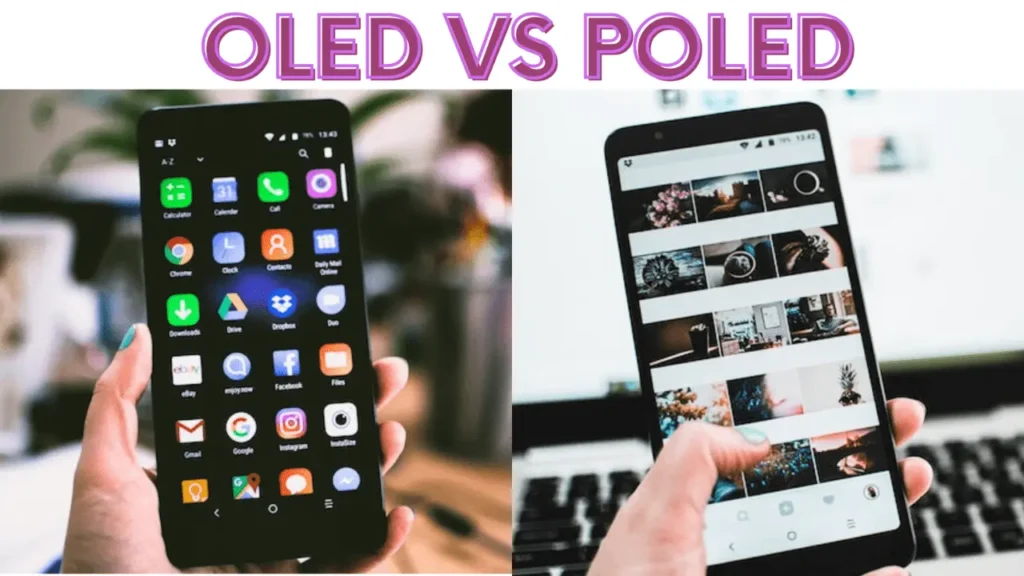You may have come across terms like OLED and POLED if you’re looking for a new smartphone, TV, or monitor. These two display technologies create high-quality images using organic light-emitting diodes (OLEDs).
But how do OLED and POLED differ from one another, and which is better for your eyes and wallet? In this post, we’ll analyze the pros and cons of OLED and POLED, go through their fundamental differences, and offer advice on which display will suit your needs the best.

What is OLED?
Organic Light Emitting Diode is the abbreviation. It is a type of display where light is produced when an electric current flows through thin organic layers.
OLED displays, in contrast to LCD displays, do not require a backlight to illuminate the pixels, allowing them to completely turn off a single pixel to produce deep blacks and excellent contrast ratios.
OLED screens are slimmer than LCD displays and provide wider viewing angles, quicker response times, and lower power consumption.
What is POLED?
Plastic OLED is referred to as POLED. It is an adaptation of OLED technology, where the display panel’s base layer is made of flexible plastic rather than glass.
The plastic substrate makes the display suitable for curved or flexible devices because it enables the display to be bent, folded, or rolled up without breaking.
In terms of visual quality and power effectiveness, POLED screens are comparable to OLED displays.
OLED vs. POLED: Which is better?
OLED vs POLED are both outstanding display technologies that provide better performance and image quality than LCD panels.
But they also differ in a few ways that, depending on your preferences and usage patterns, may influence your choice.
The following are some of the key aspects to compare between OLED and POLED:
- Display Quality: OLED displays offer a minor advantage over POLED displays in terms of display quality since the glass substrate is more transparent and clear and has better optical qualities than the plastic substrate. Moreover, compared to the glass substrate, the plastic substrate can be more susceptible to dents and deterioration over time.
- Durability: Due to the plastic substrate’s greater flexibility and resistance to cracks and shatters than the glass substrate, POLED displays are more durable than OLED displays. Both kinds of displays are nonetheless susceptible to burn-in, which is the long-term pixel deterioration brought on by displaying static images.
- Cost: Due to the ease of production and processing of the plastic substrate over the glass substrate, POLED displays are typically more affordable to create than OLED displays. However, other factors, including supply and demand, brand value, and market rivalry, may also have an impact on the pricing, making it unlikely that the cost difference would have a substantial enough impact on the final price of the devices that employ these screens.
- Availability: OLED displays are more accessible than POLED displays because of their widespread adoption by TV, monitor, and smartphone makers, including Samsung, LG, Sony, and Apple. The majority of LG’s smartphones, including the LG G Flex series and the LG V30, employ POLED displays, which are still relatively new and specialized in the market.
Conclusion
Both OLED and POLED are excellent display technologies with remarkable image quality and functionality.
They do, however, also have some benefits and drawbacks that may vary based on the user and the gadget. You might pick OLED over POLED if you want a display with superior clarity, brightness, and color accuracy.
You might choose POLED over OLED if you desire a display with greater adaptability, cost-effectiveness, and durability. The ideal display for you ultimately depends on your preferences and usage situation.
Which is better, OLED or POLED vs. AMOLED?
OLED screens come in two different varieties: POLED and AMOLED. Whereas POLEDs employ a plastic substrate, AMOLEDs use an active matrix. Nonetheless, active matrix technology and plastic substrates are used in the bulk of contemporary OLED displays. In other words, whether your smartphone has an AMOLED or POLED screen, it doesn’t really matter.
The following are the primary variations between POLED and AMOLED screens:
If visual quality and brightness are your top concerns, AMOLED panels are the best option.
If portability and durability are important to you, POLED displays are the better option.
Durability: If you desire a more affordable, svelte, and shockproof screen, POLED displays are preferable.
AMOLED panels are vulnerable to screen burn-in.
Generally speaking, OLED screens have shorter lifespans and little to
Which display is best for mobile?
The type and caliber of the display technology, as well as the user’s preferences, all play a role in determining the finest smartphone display. OLED displays, particularly the Super AMOLED one made by Samsung Display, are preferred by some experts and consumers. Others might prefer the iPhone 14 Pro Max, which received an A+ display performance rating and the “DisplayMate Best Smartphone Display Award.
Which is better, POLED or LCD?
AMOLED panels are more effective and provide higher-quality images than LCD and POLED screens. When it comes to cracks and breaking, AMOLED screens are more vulnerable than POLED screens.
Hence, it actually depends on the kind of presentation you want. I hope that was helpful.